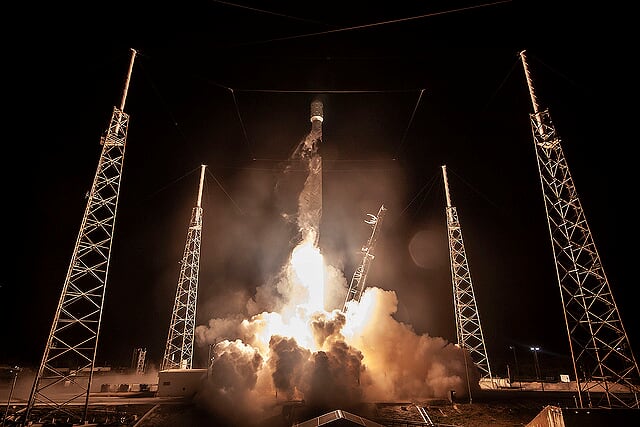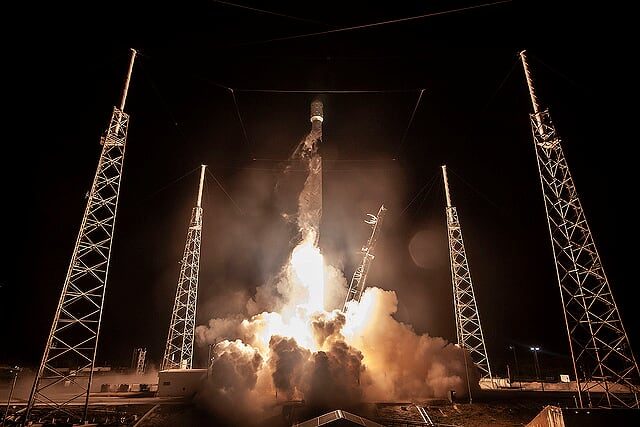
— I expected the office of SpaceIL— the company that created Beresheet, the world’s first private spacecraft to attempt a Moon landing in 2019 — to be in an industrial zone filled with highly classified, space-age robotics.
Instead, it’s in an ordinary office building with companies geared to earthly pursuits like home decorating and teeth whitening. The only sign that this is a far-reaching project is in the office’s modest conference room, where there is the replica of the four-legged Beresheet, a bit smaller than the original.
Only three other countries have landed spacecraft on the Moon: Russia, the United States and China. It boggled my mind that Kfir Damari, a soft-spoken 39-year-old with reddish hair, a thick beard, and glasses befitting Clark Kent, along with a small team of engineers and scientists, tried to make Israel the fourth nation to land successfully on the moon.
“We are the fourth to land on the moon,” said Damari. “We might have had a crash landing, but we got to the Moon. A lot of people don’t realize this. We got there.”
To the Moon with the UAE
In October, the United Arab Emirates signed a cooperation agreement with Israel to work on space exploration and Beresheet 2. The goal is to launch sometime in 2024 or 2025.
The new spacecraft, to be built on a budget of $100 million, will drop one lander on one side of the Moon and the other lander on the dark side of the Moon, where only China has ventured. Then, after dropping off the landers, the original ship will orbit the Moon for two years.
During its orbit, Damari said, it will serve as the first educational platform to engage children around the world. Beresheet 1 had engaged two million children, half of them within Israel, in the space project. He hopes that the new craft will inspire adults and children in the United Arab Emirates, Europe and Africa to create bonds with Israeli peers.
“For Israel to lead the mission and for children to do their first steps of engineering and space exploration through Israel will be amazing for Israel’s image,” he said. “I believe that when children from other countries will work with Israeli children on projects it will also shape their perspective.”
Damari added that the Beresheet2 project is not only aimed at children interested in STEM (science, technology, engineering and math).
“Can you imagine the kinds of art projects that can be done with a platform orbiting the Moon?” said Damari . He added that the Israeli Ministry of Education is already planning curriculum ideas for students from kindergarten through high school.
“For me, this is making something impactful for Israel,” he said. “It also shows how all of us can reach for something impossible and make it possible.”
Passengers in the space capsule
With a budget of $100 million, Beresheet 1 was the thriftiest spacecraft to enter lunar orbit. It was not much taller than a kitchen counter, 5 feet (1 meter) by 7.5 feet (2.3 meters), so it didn’t have a lot of room for fuel.
A week later, it began its descent toward a volcanic field called the Sea of Serenity, close to where the American Apollo 17 astronauts landed in 1972. Only 13 kilometers from the Moon, it began slowing down, preparing to land. Although hardware malfunctions prevented Beresheet from making a soft landing, the crashed spacecraft remains on the Moon.
Along with the lander, which is still on the Moon’s surface, there are souvenirs from Earth that traveled with it, including thousands of human faces in photographs taken next to the replica of the Beresheet that stood in the Duty-Free Shop at Ben Gurion International Airport for about five years.
“Me and my family and all my Facebook friends are on the Moon,” said Damari. “The goal was for them to be passengers in the space capsule, and digitally they were.”
The photos are preserved in a few magnetic discs along with optic disks that “don’t need a reader, only a microscope.” That’s assuming that whoever finds them will have the equipment and know-how to look at them.
“I can’t say if there are other civilizations out there in the universe,” said Damari. “If there are, it will be great if they come and see everything we left on Beresheet, including 15,000 books in 37 languages, all of Wikipedia, drawing and blessings of kids.”
“I can’t promise that aliens will read all of it but I’m certain that our kids and grandkids will have the opportunity,” he said.
Onboard was also a miniaturized copy of the Hebrew Bible. In fact, the first word of the Bible is beresheet, meaning “genesis” or “in the beginning.
The name for the spacecraft was chosen through a vote on Facebook. “I don’t know who suggested it but the name connects us to the past and to the future. It was Israel’s first spacecraft but not the last,” said Damari
SpaceIL wanted people to feel connected with the mission, so Beresheet was the first spacecraft to take a selfie. It showed the Moon against the logo of Beresheet, “Small nation, big dreams.”
Since the start of SpaceIL, volunteers have served as its ambassadors, traveling around the country to speak with students and adults about the space mission. There are still about 130 volunteers giving lectures in Israel and abroad.
“The volunteers go to Arab, Ethiopian, religious communities,” he said. “They want to talk to everyone about space.”
He related that one volunteer spoke at a school in Herzliya seven years ago. Recently, SpaceIL received a thank-you letter from a boy who said he had known nothing about space. The volunteer’s talk inspired him to build a nanosatellite.
“This is a new space age with new technology,” said Damari.“People can now build small, cheap satellites such as Nanosats and Cubesats.” Some of SpaceIL’s volunteers have even changed careers to go into space research.
“We are connecting as many people as possible to space,” said Damari “I look forward to having girls from the United Arab Emirates doing space projects with girls from Israel.”
When SpaceIL began in 2010, studies showed that the number of STEM majors in Israel was decreasing in proportion to the population. Since Beresheet, it has increased. “We hope to keep increasing the numbers of STEM majors from all sectors,” said Damari..
However, he doesn’t push his interests on his two children — Omer, eight, and Maayan, five. They traveled with him and his wife, Dotan, to the 2019 launch at Cape Canaveral, “but I want them to find their own dreams.”
Dotan, an occupational therapist, works with children on the autism spectrum. “She’s changing the world one person at a time,” said Damari.After high school graduation in 2000, Damari was accepted into the Israel Defense Forces’ elite intelligence unit 8200.
“I became an officer, then studied physics and space engineering at Ben-Gurion University,” he said. “In 2010, when I was teaching, Yariv Bash, an acquaintance, posed a question on Facebook. Yariv asked, ‘Who wants to go to the moon?’” said Damari..
Bash, an engineer, was inspired by the Google Lunar XPrize, an international competition offering $20 million to anyone who could land a probe on the moon.
“I asked Yariv, ‘Are you serious?’ and he said he was.” Yonatan Winetraub, also an engineer, Bash and Damari met at a bar in Holon, a small city south of Tel Aviv.
What happens when three guys dreaming of going to the moon, walk into a bar?
Their first idea was to launch a small bottle into space. When they realized they needed more equipment, and more money, they raised funds and joined forces with Israel Aerospace Industries, which eventually built the craft.
Although the $20 million Lunar XPrize was never awarded, SpaceIL received its $1 million Moonshot Award.
An underfunded startup
Damari said that compared to other countries’ space programs, SpaceIL is relatively small, underfunded, and operates more like a startup than a national space initiative.
About 40 people worked on the first mission. There are currently 20 employees. SpaceIL has raised $70 million, mostly from three main donors: the Patrick and Lina Drahi Foundation, the Moshal Space Foundation and philanthropist Morris Kahn, who announced after Beresheet 1’s crash landing, “We will complete the mission.”
SpaceIL is now raising additional funding for its next mission, along with the money needed for the craft that will orbit the moon for at least two years. Damari hopes that international partners will pitch in.
“We are not yet sure where we’ll launch from, but we will be given a window of six months, so we need to be ready,” said Damari.
Produced in association with ISRAEL21c.
Recommended from our partners
The post Getting Ready To Land On The Moon, Again appeared first on Zenger News.




